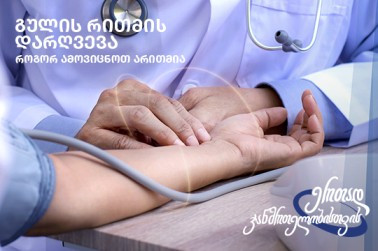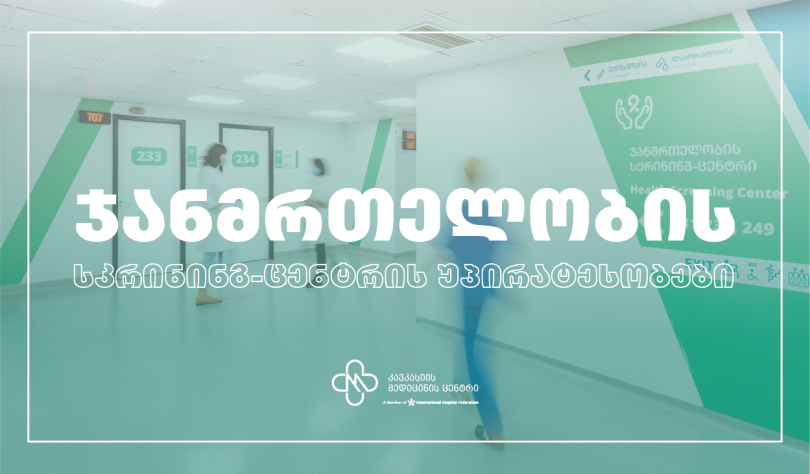


Blog
Ankle dislocation: treatment and prevention
05 March 2020

The legs are the support of our body, which are under great pressure every day. The pressure is even greater on the feet, and this is probably why ankle dislocation is being treated abroad more and more often.
Ankle health is important not only for those involved in sports, but also for those who value their well-being. After all, such injuries may play a cruel joke in the future. Therefore, it is important to treat them today.
Symptoms of ankle dislocation and first aid treatment
Ankle dislocation is characterized by a displacement of the articular surfaces of the bones, in which the capsule ruptures and nearby tissues are damaged. Therefore, treatment is always aimed at restoring the natural position of the joints.
What indicates that the person has a dislocation?
As can be seen from the symptoms, it is initially very difficult to determine the person has the fracture or dislocation and this complicates the situation.
If a person has an ankle dislocation and has the above-mentioned symptoms, then the first aid treatment is necessary. First aid can be provided as follows:
First aid is provided at this stage, but that is not enough. When providing first aid treatment, it is necessary to release the pain syndrome. And this can be done using medications, Solpadein, Tempalgin and others.
If the injury was received in the winter, then we can assume that this is an injury of the special character and it is not worth removing shoes yourself. Such an injury may be worsened by tissue cooling.
Immediately after the first aid is provided, it is necessary to go for a consultation with a traumatologist in order to exclude a leg fracture.
Then the specialist carries out an x-ray examination and necessarily an MRI, this will help to choose the right system of treatment.
Treatment of ankle dislocation
Dislocation of the ankle joint is quite common. The treatment of such an injury is complex.
First, the doctor adjusts the displaced joint, previously anesthetizing the limb. Then the ankle is fixed with a hard bandage. The leg must be fixed within 3 days.
After the fixation is removed, patient can take slow walks. This will give good service, as it will reduce puffiness, especially if you apply ice compresses during walking.
It is also worth adding medication treatment. As a rule, this is done under the complete supervision of a physician. Often, the doctor directs the patient to physiotherapeutic procedures, such as UHF, electrophoresis, magnetotherapy and thermal procedures.
Types of ankle dislocation
There are several types of foot dislocation:
Also exist:
Symptoms play a special role in the classification of dislocations. Therefore, dislocations are:
Diagnosis of ankle dislocation at CMC Hospital
Diagnosis of foot dislocation is necessary, because this is the only way to choose the right treatment and avoid complications. Therefore, the diagnosis of foot dislocation will be done effectively at СМС Hospital.
A professional traumatologist at CMC Hospital will carry out an x-ray and an MRI scan and, based on the results, will be able to make certain conclusions.
Diagnosis is always based on the implementation of palpation of the injured area. In addition, an injured person is asked questions. CT scan will be especially useful in diagnosing severe cases.
After carrying out the above procedures, the specialist begins to use local anesthesia, for further reduction of the joint. In complex cases, the specialist uses a plaster cast, and sometimes surgery is done.
Modern equipment of the CMC Hospital allows you carrying out an X-ray examination, which will help to exclude a fracture, confirm the displacement, and MRI, which will assess the condition of the soft tissues around the damaged joint.
Treatment of dislocated ankle
Dislocated ankle is treated within several stages:
Separately, it is worth highlighting surgery. This treatment method will be relevant in the case when it is impossible to adjust the dislocation. In addition, surgery is carried out in case of damage to blood vessels, nerves or ligaments located next to the joint. In the event if a dislocation repeats, surgery is done as well.
Rehabilitation is a very important stage of treatment. Rehabilitation is characterized by physiotherapy, massage, cryotherapy. These are very important methods that help improve joint mobility, normalize muscle tone.
Physiotherapy is carried out in order to relieve pain, eliminate edema, restore trophism and blood flow. Physiotherapy will be useful not only after removing the cast, but also at the stage of immobilization.
Physiotherapy includes the following procedures:
Dislocation of the foot is very common and very dangerous, so you cannot stop at first aid. If you get such an injury, you need to continue treatment, diagnosing your unique case with the help of advanced medical equipment of CMC Hospital.
Ankle health is important not only for those involved in sports, but also for those who value their well-being. After all, such injuries may play a cruel joke in the future. Therefore, it is important to treat them today.
Symptoms of ankle dislocation and first aid treatment
Ankle dislocation is characterized by a displacement of the articular surfaces of the bones, in which the capsule ruptures and nearby tissues are damaged. Therefore, treatment is always aimed at restoring the natural position of the joints.
What indicates that the person has a dislocation?
- Slight crunch during the injury;
- A sharp pain appears, which intensifies with any attempt to move a leg;
- Immediate swelling;
- Bruising;
- Cyanosis;
- Great tension of the Achilles tendon;
- Explicit deformity in the ankle joint;
- A sharp swelling of the tissues with the transition to other parts of the limbs;
- Appearance of hematoma;
As can be seen from the symptoms, it is initially very difficult to determine the person has the fracture or dislocation and this complicates the situation.
If a person has an ankle dislocation and has the above-mentioned symptoms, then the first aid treatment is necessary. First aid can be provided as follows:
- To make the injured person lay. (attempts to seat may result in an increase in swelling, and this will happen very quickly. It is important to ensure that the limb is not moving, as this minimizes pain);
- Raise an injured leg (this will help minimize swelling);
- Apply a cold compress to a sore spot (Duration should not exceed more than 10 minutes, after half an hour the procedure can be repeated. As a cold compress, ice or frozen food, a cooling spray or a cooling ointment will work).
- Bandage the leg (Preliminarily, fixation bandage can be applied. At the same time, a soft material such as cotton wool should be used between the leg and the splint. This should be done, starting with the fingers towards the middle of the foot. Use an elastic bandage, placing it crosswise and rigidly fixing);
- Under no circumstances should you try to correct the injured area yourself (this is very painful and dangerous).
First aid is provided at this stage, but that is not enough. When providing first aid treatment, it is necessary to release the pain syndrome. And this can be done using medications, Solpadein, Tempalgin and others.
If the injury was received in the winter, then we can assume that this is an injury of the special character and it is not worth removing shoes yourself. Such an injury may be worsened by tissue cooling.
Immediately after the first aid is provided, it is necessary to go for a consultation with a traumatologist in order to exclude a leg fracture.
Then the specialist carries out an x-ray examination and necessarily an MRI, this will help to choose the right system of treatment.
Treatment of ankle dislocation
Dislocation of the ankle joint is quite common. The treatment of such an injury is complex.
First, the doctor adjusts the displaced joint, previously anesthetizing the limb. Then the ankle is fixed with a hard bandage. The leg must be fixed within 3 days.
After the fixation is removed, patient can take slow walks. This will give good service, as it will reduce puffiness, especially if you apply ice compresses during walking.
It is also worth adding medication treatment. As a rule, this is done under the complete supervision of a physician. Often, the doctor directs the patient to physiotherapeutic procedures, such as UHF, electrophoresis, magnetotherapy and thermal procedures.
Types of ankle dislocation
There are several types of foot dislocation:
- Full (in this case, the bone head and articular cavity cease to contact);
- Incomplete or subluxation (the interaction of the bone head and articular cavity is partially preserved).
Also exist:
- Open dislocation (in this case, the skin surface is damaged);
- Closed dislocation (there are no visible wounds).
Symptoms play a special role in the classification of dislocations. Therefore, dislocations are:
- Fresh (when no more than 3 days have been passed after an injury);
- Not fresh (after receiving an injury, from 3 to 21 days have passed);
- Inveterate (more than 3 weeks have passed since the injury).
Diagnosis of ankle dislocation at CMC Hospital
Diagnosis of foot dislocation is necessary, because this is the only way to choose the right treatment and avoid complications. Therefore, the diagnosis of foot dislocation will be done effectively at СМС Hospital.
A professional traumatologist at CMC Hospital will carry out an x-ray and an MRI scan and, based on the results, will be able to make certain conclusions.
Diagnosis is always based on the implementation of palpation of the injured area. In addition, an injured person is asked questions. CT scan will be especially useful in diagnosing severe cases.
After carrying out the above procedures, the specialist begins to use local anesthesia, for further reduction of the joint. In complex cases, the specialist uses a plaster cast, and sometimes surgery is done.
Modern equipment of the CMC Hospital allows you carrying out an X-ray examination, which will help to exclude a fracture, confirm the displacement, and MRI, which will assess the condition of the soft tissues around the damaged joint.
Treatment of dislocated ankle
Dislocated ankle is treated within several stages:
- Reduction (this procedure is necessarily carried out under anesthesia, which has a relaxing effect on the muscles of the joint);
- Immobilization (this stage of treatment is relevant after the bones returned to their original position. Immobilization occurs using a plaster cast. How long the immobilization will take place depends on the particular type of dislocation, the degree of damage to the nerves, soft tissues and, of course, blood vessels).
- Drug therapy (This stage is necessary to reduce pain and muscle tone);
- Rehabilitation (begins after removal of the cast. Rehabilitation is necessary in order to restore the range of motion of the joint and is carried out through physiotherapy and massage).
Separately, it is worth highlighting surgery. This treatment method will be relevant in the case when it is impossible to adjust the dislocation. In addition, surgery is carried out in case of damage to blood vessels, nerves or ligaments located next to the joint. In the event if a dislocation repeats, surgery is done as well.
Rehabilitation is a very important stage of treatment. Rehabilitation is characterized by physiotherapy, massage, cryotherapy. These are very important methods that help improve joint mobility, normalize muscle tone.
Physiotherapy is carried out in order to relieve pain, eliminate edema, restore trophism and blood flow. Physiotherapy will be useful not only after removing the cast, but also at the stage of immobilization.
Physiotherapy includes the following procedures:
- UHF (electromagnetic field acts on the damaged area, thereby reducing pain, improving blood circulation and eliminating inflammation).
- Applications (realized with heated paraffin and ozokerite, which have a thermal effect on the injured area, also improving blood flow and lymph circulation);
- Magnetotherapy (a magnetic field has a therapeutic effect, improves lymphatic drainage, activates blood flow and relieves inflammation);
- Laser therapy (performed on the area around the joint, improving lymphatic drainage, also stopping inflammation and activating blood flow);
- Cryotherapy (treatment is carried out using chilled air or liquid nitrogen, which relax and dilate blood vessels).
Dislocation of the foot is very common and very dangerous, so you cannot stop at first aid. If you get such an injury, you need to continue treatment, diagnosing your unique case with the help of advanced medical equipment of CMC Hospital.
Other Blogposts

Explore Now
სიცოცხლის რიტმი: რა უნდა ვიცოდეთ გულის არითმიის შესახებ?
18 July 2024
არითმია, ანუ არარეგულარული გულისცემა, გულის ნორმალური რიტმის ნებისმიერი ტიპის დარღვევას ეწოდება. ფიზიოლოგიურად გულისცემის სიხშირე შეიძლება გაიზარდოს ფიზიკური აქტივობის შესაბამისად ან შემცირდეს მოსვენებისა და ძილის დროს. ასევე, გულისცემის გამოტოვების იშვიათი შეგრძნება, უმეტესწილად არ უკავშირდება პათოლოგიურ ცვლილებებს, თუმცა, ხშირი არარეგულარული რითმი ძირითადად მიგვანიშნებს არითმიებზე, რა დროსაც გულისცემის პათოლოგიური ცვლილების გამო, ორგანოები ვერ მარაგდება საკმარისი რაოდენობის სისხლით.

Explore Now
ბავშვი ინსულტის დიაგნოზით: 13 წლის მოზარდის განკურნების ისტორია
05 October 2022
2022 წლის დადგომას ველოდით. ალექსანდრესთან ერთად ნაძვის ხის აწყობას ვგეგმავდით. მოულოდნელად, მისი ოთახიდან უცნაური ხმები შემომესმა. სასწრაფოდ შევაღე კარი და ვნახე სრულიად გაშეშებული ჩემი შვილი, რომელიც ერთ წერტილში იყურებოდა და უემოციოდ იჯდა. მან ჩვენი ყურადღების მიქცევა მხოლოდ ხელების ოდნავი მოძრაობით შეძლო.

Explore Now
Benefits of a screening center
15 November 2021
Caucasus Medical Center plays a huge role in the development of the screening center. Here, diagnostics are performed using modern high-tech devices and the error is minimized. Also, the screening center is distinguished by the team of multidisciplinary doctors. With their joint involvement, the treatment issues of the patients are discussed.



